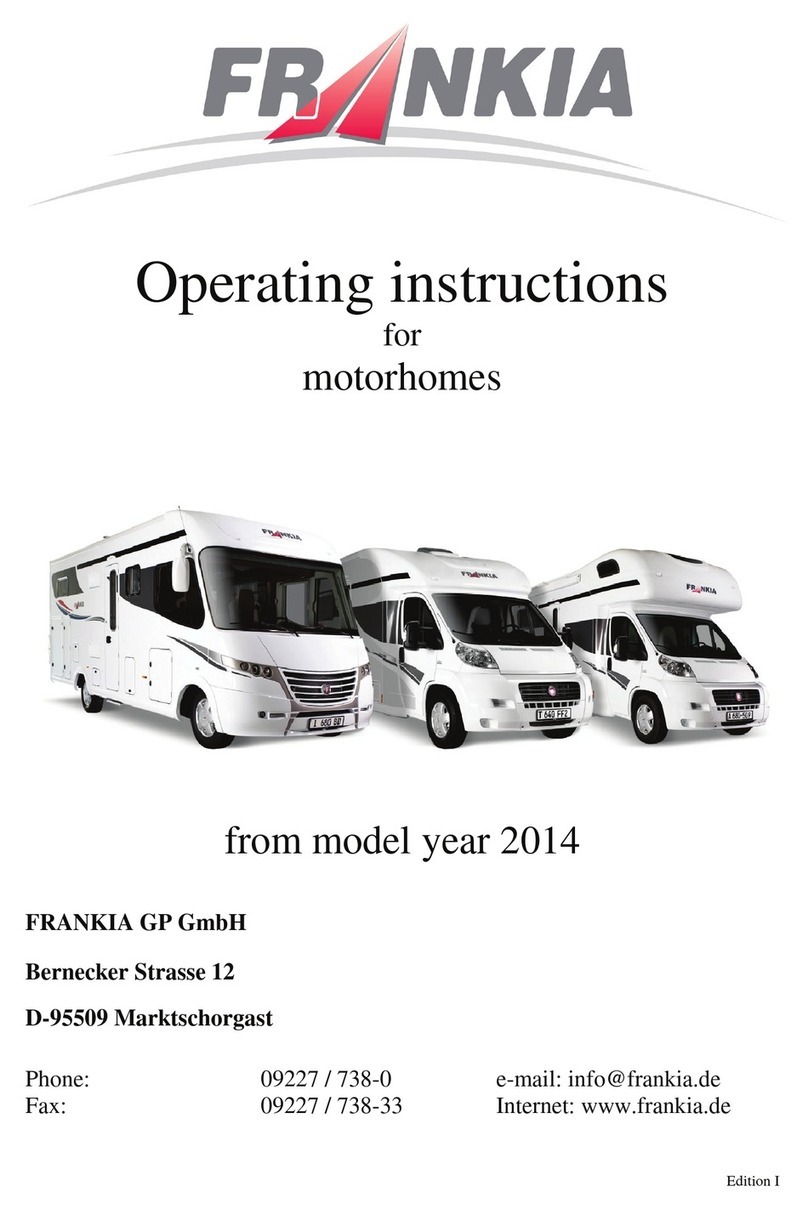
FRANKIA OPERATING MANUAL12 FRANKIA OPERATING MANUAL 13
1.5 Staying overnight in the motorhome
The following table shows the regulations of some European countries: (subject to correction)
Belgium Campsites in all parts of the country, especially near the coast, few parking spaces, outside of campsi-
tes and parking spaces only overnight stay at motorway service areas (maximum one night).
Denmark Very dense network of campsites, no parking spaces, quick-stop spaces in front of many campsites,
overnight stays outside of campsites prohibited.
Germany Very dense network of campsites, dense network of parking spaces, an overnight stay outside of cam-
ping and parking spaces allowed to restore roadworthiness, some regional prohibitions.
France Very dense network of campsites, dense network of parking spaces, overnight stays outside of camping
and parking spaces regulated by local regulations.
Greece Numerous campsites, especially on the coasts, very few parking spaces. No overnight stay outside of
campsites.
Great Britain Very dense network of campsites, no parking spaces, overnight stays outside of campsites regulated by
local regulations.
Italy
Very dense network of campsites, dense network of parking spaces, especially in northern and central Italy,
overnight stays outside of camping and parking spaces allowed for one night, observe local regulations.
Croatia Very dense network of campsites on the coast, few parking spaces, overnight stays outside of camping
and parking spaces also prohibited on private property.
Luxembourg Dense network of campsites, no parking spaces, overnight stays outside of camping and parking spaces
prohibited.
The
Netherlands
Very dense network of campsites, many camping offers at farms, few parking spaces, overnight stays
outside of camping and parking spaces prohibited.
Norway Dense network of campsites, especially in the south of the country, very few parking spaces, observe
local prohibitions when staying outside of campsites and parking spaces.
Austria Dense network of campsites, no parking spaces, overnight stays outside of camping and parking spaces
prohibited.
Sweden Dense network of campsites in the south and centre of the country, very few parking spaces, observe
local prohibitions when staying outside of campsites and parking spaces.
Switzerland Dense network of campsites, no parking spaces, overnight stays outside of camping and parking spaces
prohibited.
Spain Very dense network of campsites, few parking spaces, observe local prohibitions when staying outside
of campsites and parking spaces.
The vehicle may only be set up on private property with the permission of the property owner.
Source: Promobil Last updated: May 2012
1.6 Sleeping
The alcove beds can be used immediately. In order to facilitate access to the driver‘s cab, in the case of Plus floor plans,
the extendable central slatted frame should be inserted and locked. For all other floor plans, you can fold the bed up.
You can keep the alcove bed folded up while driving.
Before the drop-down bed in Coachbuilt motorhomes is swivelled down, the steering wheel must be pushed in comple-
tely and brought to the lowest position, the backrests of the front seats must be moved forward, and the seat height all
the way down. Swing the driver‘s seat slightly outwards so that the backrest swings past the steering wheel.
•Press the rocker switch down to lower the electric drop-down bed
•When the lower position is reached, the motors switch off automati-
cally
•To raise the electric drop-down bed, press the rocker switch upwards
•If there is a mattress or bedding on the vehicle roof, stop the process.
It is not absolutely necessary to raise the bed as far as it will go
The raised drop-down bed must not be used as a luggage rack. Only the bedding for two people may
remain on the bed. The bed may only be loaded in the lower end position.
During the adjustment process, the bed lowers and rises on both sides at different speeds due to
the design, so there is no synchronisation and the bed may be pulled into a slight incline on the way
between the upper and lower position. This has no influence on the operational safety of the bed.
Therefore, when adjusting, keep the switch pressed until both motors have moved to the lower end
position and switch off automatically. An integrated overload protection switches the drop-down bed
off automatically in the event of a collision. The system can be operated again after about 20 seconds.
Emergency operation in the event of a defect in the linear drives is described from Section 9.8.




























